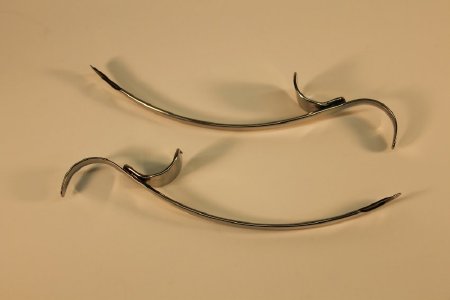Object ID Number:
2017.000.082
Object Name:
Commissurotomy Knife
Date of Manufacture:
1950/ /
Manufactured from:
1948
Manufactured to:
1960
Description / History:
Bailey Commissurotomy knife used for mitral stenosis – (2)
Left and Right Commissurotomy Knives designed by Dr. Charles Bailey and produced in Philadelphia, PA. c.1950
These knives were used for the treatment of the heart condition mitral stenosis, in the first series of truly modern heart surgeries.
This set of commissurotomy knives was donated to EHMHF by Dr. William Atlee.
Left and Right Commissurotomy Knives designed by Dr. Charles Bailey and produced in Philadelphia, PA. c.1950
These knives were used for the treatment of the heart condition mitral stenosis, in the first series of truly modern heart surgeries.
This set of commissurotomy knives was donated to EHMHF by Dr. William Atlee.
Dimensions:
L–7.5 inches
Additional Information:
Dr. Charles Bailey's Commissurotomy Knives
The first successful series of truly modern cardiac surgeries were performed by Dr. Dwight Harken, a U.S. army surgeon, in the week following D–day (June 6, 1944). Although, before Dr. Harken's work, cardiac operations had previously been considered too dangerous; in the week following the American invasion of France, Dr. Harken saved 134 young men (out of the 134 on which he operated) by removing pieces of shrapnel lodged in or around their hearts. Some of the operations were truly stunning, as he would sometimes simply stab a surgical clamp into the heart, pull out the piece of shrapnel, and stop blood from gushing from the hole in the heart with his hand (often by sewing his rubber glove directly to the heart!). With these incredibly bold and consistently successful surgeries, Dr. Harken made the first large step towards modern cardiac surgery.
Dr. Harken's procedures laid the foundation for surgery to alleviate the cardiac condition known as mitral stenosis; probably the first cardiac surgical procedure to be developed. At the turn of the century, rheumatic fever had become a widespread disease, with pathology of the mitral valve as a frequent associated condition. In most cases, the mitral valve (which separates the left atrium, the heart chamber which receives oxygenated blood from the lungs, from the left ventricle, the heart chamber which pumps the oxygenated blood through the body) would become thickened and hardened, and would allow blood from the left ventricle to leak back into the left atrium. This leaking was a frequent cause of cardiovascular mortality, and patients with this condition often had an extremely poor prognosis.
To alleviate this condition, in 1948, Dr. Charles Bailey, a professor of thoracic surgery at the Hahnemann Medical College in Philadelphia, developed a pair of curved knives which could be used to cut apart the thickened flaps of the mitral valve. After four unsuccessful surgeries, for which he received harsh criticism, he finally performed a successful mitral valve repair, termed a "commissurotomy" on a 24 year old housewife who had recently experienced congestive heart failure. Although, had he been governed by today's ethical standards, he may not have been allowed to continue, Dr. Bailey's successful commissurotomy became a standard practice to alleviate mitral valve repair, and surgical interventions to alleviate mitral valve repair are still performed today.
The first successful series of truly modern cardiac surgeries were performed by Dr. Dwight Harken, a U.S. army surgeon, in the week following D–day (June 6, 1944). Although, before Dr. Harken's work, cardiac operations had previously been considered too dangerous; in the week following the American invasion of France, Dr. Harken saved 134 young men (out of the 134 on which he operated) by removing pieces of shrapnel lodged in or around their hearts. Some of the operations were truly stunning, as he would sometimes simply stab a surgical clamp into the heart, pull out the piece of shrapnel, and stop blood from gushing from the hole in the heart with his hand (often by sewing his rubber glove directly to the heart!). With these incredibly bold and consistently successful surgeries, Dr. Harken made the first large step towards modern cardiac surgery.
Dr. Harken's procedures laid the foundation for surgery to alleviate the cardiac condition known as mitral stenosis; probably the first cardiac surgical procedure to be developed. At the turn of the century, rheumatic fever had become a widespread disease, with pathology of the mitral valve as a frequent associated condition. In most cases, the mitral valve (which separates the left atrium, the heart chamber which receives oxygenated blood from the lungs, from the left ventricle, the heart chamber which pumps the oxygenated blood through the body) would become thickened and hardened, and would allow blood from the left ventricle to leak back into the left atrium. This leaking was a frequent cause of cardiovascular mortality, and patients with this condition often had an extremely poor prognosis.
To alleviate this condition, in 1948, Dr. Charles Bailey, a professor of thoracic surgery at the Hahnemann Medical College in Philadelphia, developed a pair of curved knives which could be used to cut apart the thickened flaps of the mitral valve. After four unsuccessful surgeries, for which he received harsh criticism, he finally performed a successful mitral valve repair, termed a "commissurotomy" on a 24 year old housewife who had recently experienced congestive heart failure. Although, had he been governed by today's ethical standards, he may not have been allowed to continue, Dr. Bailey's successful commissurotomy became a standard practice to alleviate mitral valve repair, and surgical interventions to alleviate mitral valve repair are still performed today.
